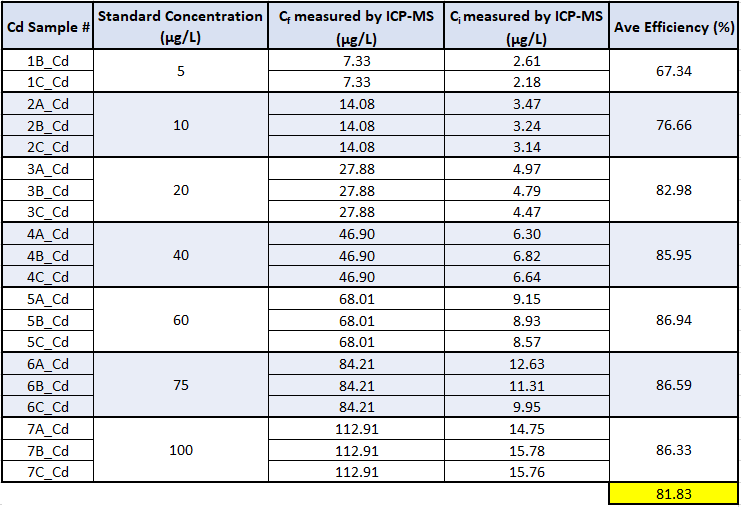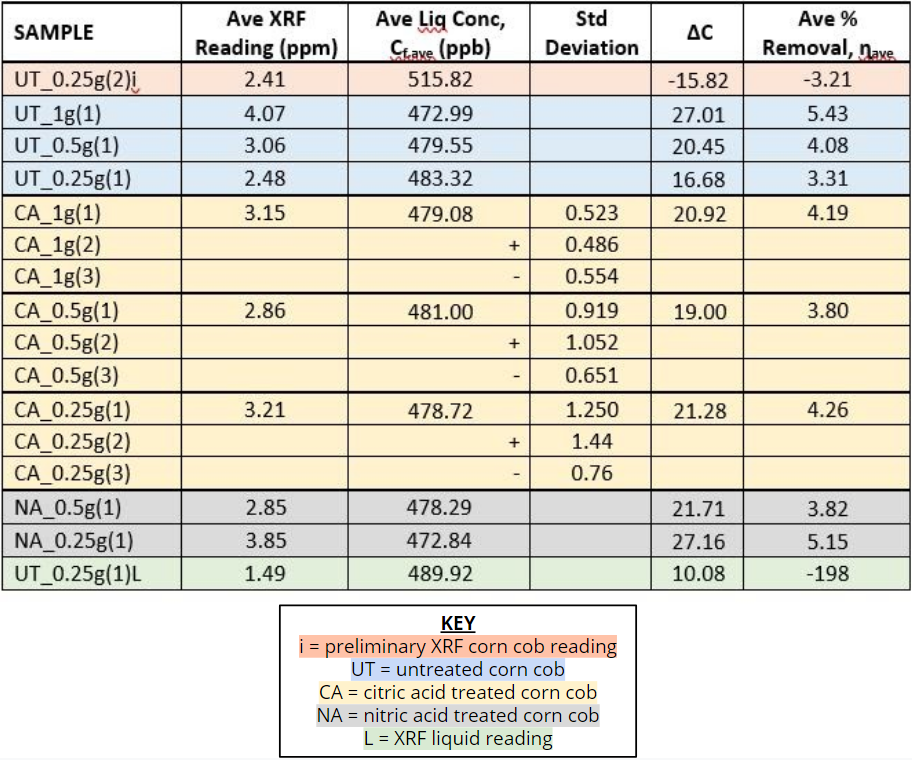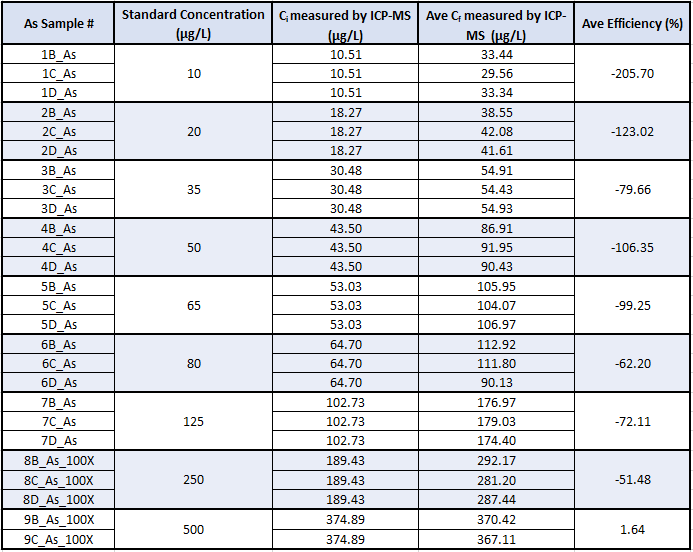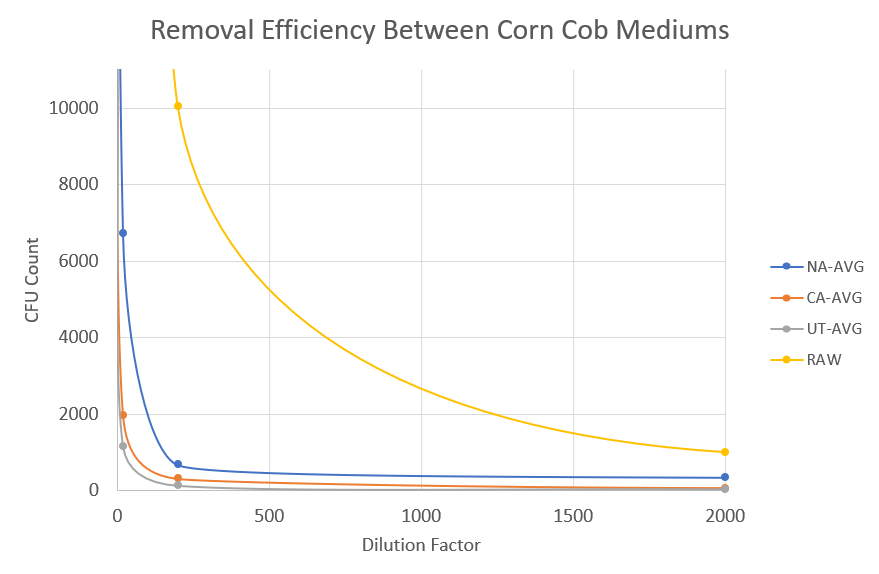The results of all testing can be found here, along with the conclusions and recommendations made by the team.
The prepared samples were analyzed via ICP-MS analysis. The range of removal from this year’s testing spanned between 68% and 87%, averaging a 82% removal efficiency. This did not meet the expected 97% removal efficiency from last year's testing, therefore, the points gained from this year's research were not added to last year's isotherm, but rather used to create another isotherm model. Both models have been plotted together on one graph and can be found directly below. As the 2019 data, seen in orange, used a linear Freundlich, isotherm model with the y-intercept through 0, as represented in Equation 1, the same was done for the 2020 model. While this year's efficiency was not as effective as the prior results, shown by the different trendline slopes, the coefficient of determination (R-squared) presents significant correlation within the respective data sets, 0.97 for this year's data and 0.86 for the 2019 data. This proved that nitric acid treated corn was still highly relevant for its purpose in removing Cadmium. Detailed data from this test can be found in the table that is under the isotherm model. The inconsistencies between the two data sets are thought to be from human variables such as unpublished changes in procedures and the difficulties of continuing research work after one year, with a completely new group of individuals.
Cadmium Isotherm from ICP-MS Analysis, 2019 vs. 2020

ICP-MS Cadmium Data

Sorption Capacity Tests
An XRF device was used to read the before sorption testing and after sorption testing levels of Arsenic in untreated corn cob, nitric acid treated corn cob, and citric acid treated corn cob. These XRF results for Arsenic can be seen below, note that the small pool of data is because many samples did not have any readings of Arsenic by the XRF device. The results show the XRF reading for Arsenic and the final liquid concentration calculated using a mass balance equation. The sample denoted with an ‘i’, in orange, represents an initial corn cob reading, which was performed to ensure there was no Arsenic present before testing. The sample denoted with an “L”, in green, was a final liquid concentration, providing disparaging results since the starting concentration was below the XRF’s LOD (limit of detection). The best results were obtained using citric acid treated corn, seen in yellow. All replicates provided results, allowing us to create error bars based on the standard deviation. Nitric acid treated corn cob in gray requires more tests to validate the two shown (since replicates were not performed during sorption testing), and untreated corn in blue had inconsistencies leading us to believe the XRF was not viable for Arsenic analysis. All of this data can be found in the table below.
XRF Arsenic Data

Sorption tests were executed to determine whether time affected the sorption capacity of various corn cob masses (1.0, 0.5, and 0.25 grams). It was assumed the 0.25 gram samples would require more time to reach sorption capacity, but all sample masses for untreated corn appear to max out at 3-hours of contact time, at 461.23 and 442.11 ppb, respectively, with the other three contact times having greater final concentrations but similar results. However, the variability of the results for the masses, requires further testing to determine the reliability of the XRF for biosorption experiments at concentrations below the LOD.
Graphical Analysis of Untreated Corn Cob XRF Results

Arsenic
ICP-MS analysis was also employed, specifically for nitric acid treated corn cob with the nine concentrations. Like Cadmium, an initial concentration was determined with the ICP device, to signify the accuracy of the Sodium Arsenite solution used to create all of the sample solutions. Contrasting the XRF readings, ICP-MS provided consistent greater final concentrations, leading to negative removal efficiencies, except for Sample 9. All of this data can be found in the table below.
ICP-MS Arsenic Results

Total Coliforms
For all corn cob types, there was a significant level of removal of Total Coliforms. Dilution factors ranging from 2 to 2,000,000 were done for each sample and each dilution showed a reduction of colony forming units (CFUs) when compared to the untreated wastewater. The average removal efficiencies for nitric acid treated corn cob, citric acid treated corn cob, and untreated corn cob were 80.65%, 88.82%, and 97.90%, respectively. The untreated corn cob had the highest removal efficiency. This may be due to organic properties that have not been stripped away in the acid treatment processes. The biological properties of Total Coliforms may not adsorb to the chemical properties of the acid treated corn cob. Below is the data from the raw primary effluent that was used as an "initial" concentration and the untreated corn cob treated primary effluent.
Total Coliforms Data, Untreated Primary Effluent vs. Untreated Corn Cob Treated Primary Effluent

Total Coliforms Removal Efficiency
Please note the following abbreviations from the figure below: NA=Nitric acid treated corn cob, CA=Citric acid treated corn cob, UT=untreated corn cob, and Raw indicates untreated, raw wastewater. See the Final Report under the Documents tab for all raw and processed data.

Recommendations & Conclusions
The results of the analysis as shown the team many things that need to be improved. To begin with, the differences in removal efficiencies of the Cadmium testing may be due to differences between the lab methodology of the 2019 and the methodology used this year. However, the resulting data, while not consistent between the years of research, has proven that corn cob is a very viable biosorbent in the removal of Cadmium, seen by the R-squared values of both data sets. If further testing were to be conducted, it is recommended to test the removal efficiency of Cadmium using the weak acid activated corn cob.
Regarding the removal of Arsenic with the corn cob biosorbent, the resulting data suggests that the XRF methodology for organic matters requires more fine-tuning to yield more conclusive results. The first recommendation if XRF analysis is desired, a higher initial concentration of Arsenic may allow for more accurate data collection. A different contaminant may also produce better results with the XRF device. Very low concentrations of a contaminate that does not adsorb to corn cob could very well be the reasons in which our results were inconclusive.
The Total Coliforms testing saw great removal efficiencies by all three of the biosorbent types, ranging from 80.65% to 98.69%, showed the treatment’s potential at reducing CFUs within primary effluent. It would be beneficial to look into other methodologies that would further validate the results gathered from this research project. Here are a few alternative methodologies: EPA Method 1604, HACH Method 10029, and Standard Method 9222J.
Updated: 5 May 2020, 10:00AM
Copyright © 2015 · All Rights Reserved
An XRF device was used to read the before sorption testing and after sorption testing levels of Arsenic in untreated corn cob, nitric acid treated corn cob, and citric acid treated corn cob. These XRF results for Arsenic can be seen below, note that the small pool of data is because many samples did not have any readings of Arsenic by the XRF device. The results show the XRF reading for Arsenic and the final liquid concentration calculated using a mass balance equation. The sample denoted with an ‘i’, in orange, represents an initial corn cob reading, which was performed to ensure there was no Arsenic present before testing. The sample denoted with an “L”, in green, was a final liquid concentration, providing disparaging results since the starting concentration was below the XRF’s LOD (limit of detection). The best results were obtained using citric acid treated corn, seen in yellow. All replicates provided results, allowing us to create error bars based on the standard deviation. Nitric acid treated corn cob in gray requires more tests to validate the two shown (since replicates were not performed during sorption testing), and untreated corn in blue had inconsistencies leading us to believe the XRF was not viable for Arsenic analysis. All of this data can be found in the table below.
XRF Arsenic Data
Sorption tests were executed to determine whether time affected the sorption capacity of various corn cob masses (1.0, 0.5, and 0.25 grams). It was assumed the 0.25 gram samples would require more time to reach sorption capacity, but all sample masses for untreated corn appear to max out at 3-hours of contact time, at 461.23 and 442.11 ppb, respectively, with the other three contact times having greater final concentrations but similar results. However, the variability of the results for the masses, requires further testing to determine the reliability of the XRF for biosorption experiments at concentrations below the LOD.
Graphical Analysis of Untreated Corn Cob XRF Results

Arsenic
ICP-MS analysis was also employed, specifically for nitric acid treated corn cob with the nine concentrations. Like Cadmium, an initial concentration was determined with the ICP device, to signify the accuracy of the Sodium Arsenite solution used to create all of the sample solutions. Contrasting the XRF readings, ICP-MS provided consistent greater final concentrations, leading to negative removal efficiencies, except for Sample 9. All of this data can be found in the table below.
ICP-MS Arsenic Results

Total Coliforms
For all corn cob types, there was a significant level of removal of Total Coliforms. Dilution factors ranging from 2 to 2,000,000 were done for each sample and each dilution showed a reduction of colony forming units (CFUs) when compared to the untreated wastewater. The average removal efficiencies for nitric acid treated corn cob, citric acid treated corn cob, and untreated corn cob were 80.65%, 88.82%, and 97.90%, respectively. The untreated corn cob had the highest removal efficiency. This may be due to organic properties that have not been stripped away in the acid treatment processes. The biological properties of Total Coliforms may not adsorb to the chemical properties of the acid treated corn cob. Below is the data from the raw primary effluent that was used as an "initial" concentration and the untreated corn cob treated primary effluent.
Total Coliforms Data, Untreated Primary Effluent vs. Untreated Corn Cob Treated Primary Effluent

Total Coliforms Removal Efficiency
Please note the following abbreviations from the figure below: NA=Nitric acid treated corn cob, CA=Citric acid treated corn cob, UT=untreated corn cob, and Raw indicates untreated, raw wastewater. See the Final Report under the Documents tab for all raw and processed data.

Recommendations & Conclusions
The results of the analysis as shown the team many things that need to be improved. To begin with, the differences in removal efficiencies of the Cadmium testing may be due to differences between the lab methodology of the 2019 and the methodology used this year. However, the resulting data, while not consistent between the years of research, has proven that corn cob is a very viable biosorbent in the removal of Cadmium, seen by the R-squared values of both data sets. If further testing were to be conducted, it is recommended to test the removal efficiency of Cadmium using the weak acid activated corn cob.
Regarding the removal of Arsenic with the corn cob biosorbent, the resulting data suggests that the XRF methodology for organic matters requires more fine-tuning to yield more conclusive results. The first recommendation if XRF analysis is desired, a higher initial concentration of Arsenic may allow for more accurate data collection. A different contaminant may also produce better results with the XRF device. Very low concentrations of a contaminate that does not adsorb to corn cob could very well be the reasons in which our results were inconclusive.
The Total Coliforms testing saw great removal efficiencies by all three of the biosorbent types, ranging from 80.65% to 98.69%, showed the treatment’s potential at reducing CFUs within primary effluent. It would be beneficial to look into other methodologies that would further validate the results gathered from this research project. Here are a few alternative methodologies: EPA Method 1604, HACH Method 10029, and Standard Method 9222J.
Updated: 5 May 2020, 10:00AM
Copyright © 2015 · All Rights Reserved
ICP-MS analysis was also employed, specifically for nitric acid treated corn cob with the nine concentrations. Like Cadmium, an initial concentration was determined with the ICP device, to signify the accuracy of the Sodium Arsenite solution used to create all of the sample solutions. Contrasting the XRF readings, ICP-MS provided consistent greater final concentrations, leading to negative removal efficiencies, except for Sample 9. All of this data can be found in the table below.
ICP-MS Arsenic Results

Total Coliforms
For all corn cob types, there was a significant level of removal of Total Coliforms. Dilution factors ranging from 2 to 2,000,000 were done for each sample and each dilution showed a reduction of colony forming units (CFUs) when compared to the untreated wastewater. The average removal efficiencies for nitric acid treated corn cob, citric acid treated corn cob, and untreated corn cob were 80.65%, 88.82%, and 97.90%, respectively. The untreated corn cob had the highest removal efficiency. This may be due to organic properties that have not been stripped away in the acid treatment processes. The biological properties of Total Coliforms may not adsorb to the chemical properties of the acid treated corn cob. Below is the data from the raw primary effluent that was used as an "initial" concentration and the untreated corn cob treated primary effluent.
Total Coliforms Data, Untreated Primary Effluent vs. Untreated Corn Cob Treated Primary Effluent

Total Coliforms Removal Efficiency
Please note the following abbreviations from the figure below: NA=Nitric acid treated corn cob, CA=Citric acid treated corn cob, UT=untreated corn cob, and Raw indicates untreated, raw wastewater. See the Final Report under the Documents tab for all raw and processed data.

Recommendations & Conclusions
The results of the analysis as shown the team many things that need to be improved. To begin with, the differences in removal efficiencies of the Cadmium testing may be due to differences between the lab methodology of the 2019 and the methodology used this year. However, the resulting data, while not consistent between the years of research, has proven that corn cob is a very viable biosorbent in the removal of Cadmium, seen by the R-squared values of both data sets. If further testing were to be conducted, it is recommended to test the removal efficiency of Cadmium using the weak acid activated corn cob.
Regarding the removal of Arsenic with the corn cob biosorbent, the resulting data suggests that the XRF methodology for organic matters requires more fine-tuning to yield more conclusive results. The first recommendation if XRF analysis is desired, a higher initial concentration of Arsenic may allow for more accurate data collection. A different contaminant may also produce better results with the XRF device. Very low concentrations of a contaminate that does not adsorb to corn cob could very well be the reasons in which our results were inconclusive.
The Total Coliforms testing saw great removal efficiencies by all three of the biosorbent types, ranging from 80.65% to 98.69%, showed the treatment’s potential at reducing CFUs within primary effluent. It would be beneficial to look into other methodologies that would further validate the results gathered from this research project. Here are a few alternative methodologies: EPA Method 1604, HACH Method 10029, and Standard Method 9222J.
Updated: 5 May 2020, 10:00AM
Copyright © 2015 · All Rights Reserved
For all corn cob types, there was a significant level of removal of Total Coliforms. Dilution factors ranging from 2 to 2,000,000 were done for each sample and each dilution showed a reduction of colony forming units (CFUs) when compared to the untreated wastewater. The average removal efficiencies for nitric acid treated corn cob, citric acid treated corn cob, and untreated corn cob were 80.65%, 88.82%, and 97.90%, respectively. The untreated corn cob had the highest removal efficiency. This may be due to organic properties that have not been stripped away in the acid treatment processes. The biological properties of Total Coliforms may not adsorb to the chemical properties of the acid treated corn cob. Below is the data from the raw primary effluent that was used as an "initial" concentration and the untreated corn cob treated primary effluent.
Total Coliforms Data, Untreated Primary Effluent vs. Untreated Corn Cob Treated Primary Effluent

Total Coliforms Removal Efficiency
Please note the following abbreviations from the figure below: NA=Nitric acid treated corn cob, CA=Citric acid treated corn cob, UT=untreated corn cob, and Raw indicates untreated, raw wastewater. See the Final Report under the Documents tab for all raw and processed data.

Recommendations & Conclusions
The results of the analysis as shown the team many things that need to be improved. To begin with, the differences in removal efficiencies of the Cadmium testing may be due to differences between the lab methodology of the 2019 and the methodology used this year. However, the resulting data, while not consistent between the years of research, has proven that corn cob is a very viable biosorbent in the removal of Cadmium, seen by the R-squared values of both data sets. If further testing were to be conducted, it is recommended to test the removal efficiency of Cadmium using the weak acid activated corn cob.
Regarding the removal of Arsenic with the corn cob biosorbent, the resulting data suggests that the XRF methodology for organic matters requires more fine-tuning to yield more conclusive results. The first recommendation if XRF analysis is desired, a higher initial concentration of Arsenic may allow for more accurate data collection. A different contaminant may also produce better results with the XRF device. Very low concentrations of a contaminate that does not adsorb to corn cob could very well be the reasons in which our results were inconclusive.
The Total Coliforms testing saw great removal efficiencies by all three of the biosorbent types, ranging from 80.65% to 98.69%, showed the treatment’s potential at reducing CFUs within primary effluent. It would be beneficial to look into other methodologies that would further validate the results gathered from this research project. Here are a few alternative methodologies: EPA Method 1604, HACH Method 10029, and Standard Method 9222J.
Updated: 5 May 2020, 10:00AM
Copyright © 2015 · All Rights Reserved
The results of the analysis as shown the team many things that need to be improved. To begin with, the differences in removal efficiencies of the Cadmium testing may be due to differences between the lab methodology of the 2019 and the methodology used this year. However, the resulting data, while not consistent between the years of research, has proven that corn cob is a very viable biosorbent in the removal of Cadmium, seen by the R-squared values of both data sets. If further testing were to be conducted, it is recommended to test the removal efficiency of Cadmium using the weak acid activated corn cob.
Regarding the removal of Arsenic with the corn cob biosorbent, the resulting data suggests that the XRF methodology for organic matters requires more fine-tuning to yield more conclusive results. The first recommendation if XRF analysis is desired, a higher initial concentration of Arsenic may allow for more accurate data collection. A different contaminant may also produce better results with the XRF device. Very low concentrations of a contaminate that does not adsorb to corn cob could very well be the reasons in which our results were inconclusive.
The Total Coliforms testing saw great removal efficiencies by all three of the biosorbent types, ranging from 80.65% to 98.69%, showed the treatment’s potential at reducing CFUs within primary effluent. It would be beneficial to look into other methodologies that would further validate the results gathered from this research project. Here are a few alternative methodologies: EPA Method 1604, HACH Method 10029, and Standard Method 9222J.